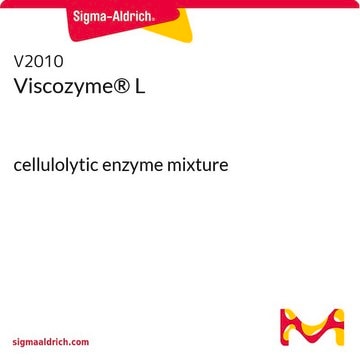This product is a partially purified, diafiltered, lyophilized cellulase complex containing exo- and endoglucanase activities. It is a native protein and does not include a His-tag.
Wichtige Dokumente
C8546
Cellulase from Trichoderma reesei ATCC 26921
lyophilized powder, ≥1 unit/mg solid
Synonym(e):
1,4-(1,3:1,4)-β-D-Glucan 4-glucano-hydrolase
Größe auswählen
€ 114,00
Voraussichtliches Versanddatum17. April 2025
Größe auswählen
About This Item
€ 114,00
Voraussichtliches Versanddatum17. April 2025
Empfohlene Produkte
Form
lyophilized powder
Qualitätsniveau
Spezifische Aktivität
≥1 unit/mg solid
Grünere Alternativprodukt-Eigenschaften
Waste Prevention
Design for Energy Efficiency
Learn more about the Principles of Green Chemistry.
sustainability
Greener Alternative Product
Löslichkeit
deionized water: soluble 5.0 mg/mL (Sterile; In the presence of 0.15% polyhexamethylene biguanide (PHMB).)
Grünere Alternativprodukt-Kategorie
Lagertemp.
2-8°C
Allgemeine Beschreibung
Anwendung
Biochem./physiol. Wirkung
Einheitendefinition
Angaben zur Herstellung
Sonstige Hinweise
Substrat
Signalwort
Danger
H-Sätze
Gefahreneinstufungen
Resp. Sens. 1
Lagerklassenschlüssel
11 - Combustible Solids
WGK
WGK 1
Flammpunkt (°F)
Not applicable
Flammpunkt (°C)
Not applicable
Persönliche Schutzausrüstung
dust mask type N95 (US), Eyeshields, Faceshields, Gloves
Hier finden Sie alle aktuellen Versionen:
Analysenzertifikate (COA)
Die passende Version wird nicht angezeigt?
Wenn Sie eine bestimmte Version benötigen, können Sie anhand der Lot- oder Chargennummer nach einem spezifischen Zertifikat suchen.
Besitzen Sie dieses Produkt bereits?
In der Dokumentenbibliothek finden Sie die Dokumentation zu den Produkten, die Sie kürzlich erworben haben.
Kunden haben sich ebenfalls angesehen
Protokolle
To standardize an enzymatic assay procedure of cellulase.
-
How has this enzyme been purified, Does it have a His-tag?
1 answer-
Helpful?
-
Active Filters
Unser Team von Wissenschaftlern verfügt über Erfahrung in allen Forschungsbereichen einschließlich Life Science, Materialwissenschaften, chemischer Synthese, Chromatographie, Analytik und vielen mehr..
Setzen Sie sich mit dem technischen Dienst in Verbindung.







